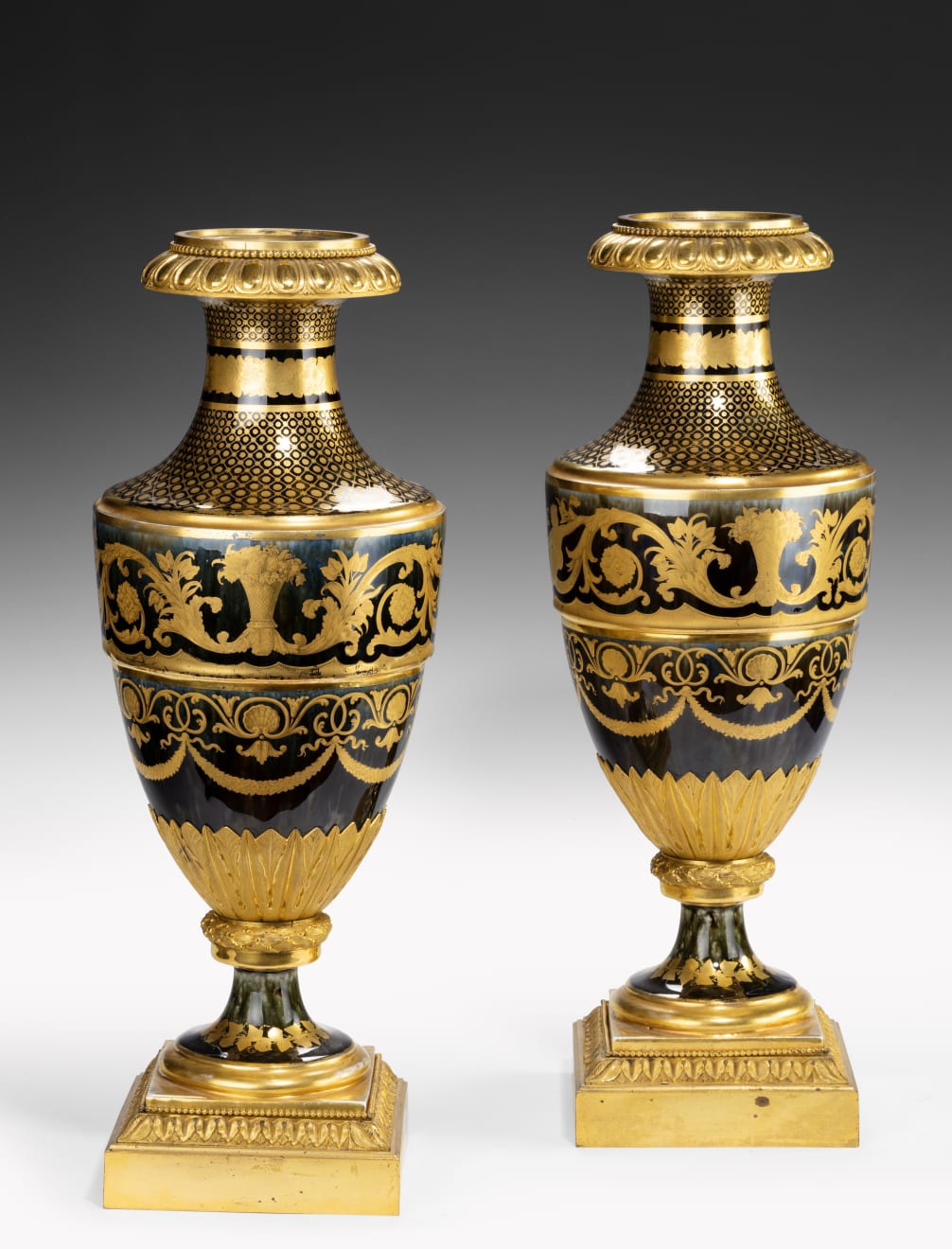Pair of Ormolu-Mounted Agate Ground Porcelain Vases
FRANCE – PARIS, circa 1800
Signed ‘M.Dihl’ on underside of the porcelain base.
51 x 20 x 20 cm
Both with a circular ormolu top with bead moulding and an egg-and-dart moulded rim above the spreading neck. With inset fruit decoration to the collar, centering lozenge pattern decoration with central circles, and stylised flowerheads at each junction. The body with a panel of scrolling stylised decoration of foliate form terminating in flowerheads and half-figures above scrolling stylised foliate decoration issuing from shells and with hanging garlands. The bases of the vases with ormolu leaf decoration above a wreath band. The whole raised on a socle with ivy and leaf decoration. The moulded circular edge set on an ormolu square base with bead moulding above lotus-leaf decoration set on a plain plinth. Produced by the celebrated Parisian Dihl and Guérhard porcelain manufactory.
Dihl and Guérhard porcelain manufactory (1781-1828): Christophe Dihl (1752-1830) was a porcelain modeller, originally from Neustadt. In 1781, Dihl and his business partner Antoine Guérhard (d.1793) established a factory. In 1765, a source for kaolin, the essential raw material in hard-paste porcelain, had been discovered near Limoges in France. A Royal Decree in 1766 relaxed prohibitions on porcelain factories, with the intention of encouraging development of this material. Despite this, the Sèvres factory retained its royal patronage and its exclusive right to produce sculptural, multi-coloured and gilded porcelain as the Decree only allowed the other porcelain factories to produce domestic porcelain, decorated in underglaze blue or a single enamel colour (‘en camaïeu’), insisting factory marks be added. After the death of Louis XV in 1774, a number of French factories which were protected by their aristocratic patronage, disregarded these restrictions. Dihl and Guérhard, under the protection of the Duc d’Angoulême, a nephew of Louis XVI, which enabled them to manufacture coloured and gilt porcelain which had been monopolised by Sèvres since 1766, opened their factory at Rue de Bondy, Paris.
The gilt decoration and chased ormolu mounts on this pair of vases indicate that they would have formed part of an important commission. Dihl’s clients included some of the most celebrated figures of the period. In 1804 a magnificent table top decorated with classical scenes was presented by Napoleon to Charles IV of Spain and Queen Marie Louise. In 1792 a table service belonging to the late Marquis de la Luzerne, former French ambassador to the English court, was sold in London, while Benjamin Franklin bought a tea service for his daughter during his nine-year residence in Paris.
A portrait of Christoph Dihl, painted by Etienne-Charles Le Guay, includes a vase of similar shape and decoration to our pair standing on his bureau similar type, and also with a ground simulating agate. This porcelain plaque, now in the collection of the Musée National de Céramique de Sèvres, is signed and dated 1797.
Dihl was a man of broad scientific interests whose focus was on research into colours. He investigated effects which simulated hardstones, a technique which he used on our pair of vases. Le Guay’s portrait shows Dihl with his palette, and Dihl is acknowledged to have been the first to establish a complete palette of colours which could be used to decorate hard paste porcelain.
Dihl’s work was highly regarded and there were close links between the Dihl and Sèvres factories. The Dihl factory won a number of important awards, including a gold medal at the Exposition des produits de l’industrie française in 1806. Unlike other factories, Dihl’s did not suffer during and after the Revolution, in part due to trade with England. In 1789, Dihl moved to new premises in the Rue du Temple (1789-1828). During this period the pieces were signed ‘Dihl’, ‘M. Dihl’ or ‘Dihl et Guérhard, Paris’.
Comparators:
The Metropolitan Museum of Art, New York has a similar sized and shaped pair of hard-paste porcelain vases by Dihl and Guérhard in its collection. This pair are decorated with scenes of storms on land, circa 1790–95 (Accession Numbers: 2014.68.1 and 2014.68.2). The cataloguing states that ‘these two vases were made at the time of the French Revolution, at a factory that was located in the heart of Revolutionary Paris. Decorated with landscapes depicting severe storms, the people in both landscapes are at the mercy of the wild forces of nature. These scenes, highly unusual for French porcelain, can be plausibly seen as reflections of the tumultuous period during which the vases were produced.’
Vase with scenes of storm at sea by Dihl and Guérhard; France, 1790–95; Metropolitan Museum of Art; Accession Numbers: 2014.68.1 and 2014.68.2; https://www.metmuseum.org/art/collection/search/644111; and https://www.metmuseum.org/art/collection/search/644110
A single hard-paste porcelain vase, painted in enamels and gilded is housed in the collection of the Victoria & Albert Museum, circa 1790-95; (Museum number: 309:1, 2-1876). This vase is a very similar shape to ours. The subject matter of the vase’s decoration – the Abduction of the Sabines – is an event reported to have taken place in 750 BC. The vase was made by the Dihl and Guérhard porcelain factory and was painted by Etienne-Charles Le Guay.
Vase by Dihl and Guérhard; painted by Etienne-Charles Le Guay; France, circa 1790-95; Victoria & Albert Museum, Museum number: 309:1, 2-1876; https://collections.vam.ac.uk/item/O301276/vase-le-guay-etienne/
The National Trust has a pair of hard-paste porcelain vases, signed by Dihl and Guérhard, circa 1797–1804 and painted by Etienne-Charles Le Guay in the collection of Clandon Park, Surrey (NT 1440746.1 and 1440746.2).
http://www.nationaltrustcollections.org.uk/object/1440746.1 and http://www.nationaltrustcollections.org.uk/object/1440746.2

